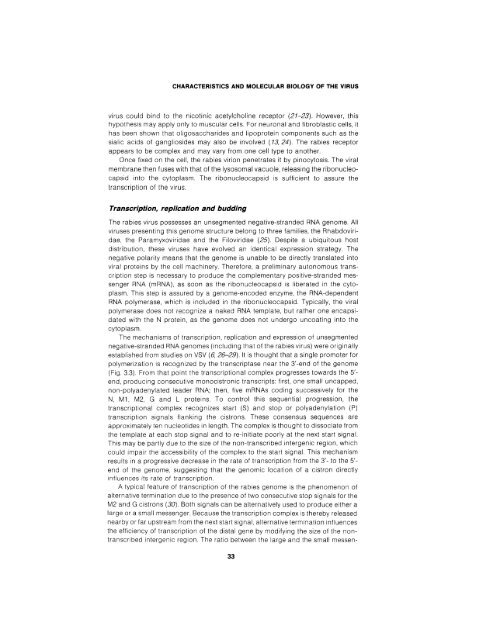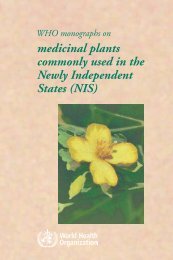in rabies - libdoc.who.int - World Health Organization
in rabies - libdoc.who.int - World Health Organization
in rabies - libdoc.who.int - World Health Organization
Create successful ePaper yourself
Turn your PDF publications into a flip-book with our unique Google optimized e-Paper software.
CHARACTERISTICS AND MOLECULAR BIOLOGY OF THE VIRUS<br />
virus could b<strong>in</strong>d to the nicot<strong>in</strong>ic acetylchol<strong>in</strong>e receptor (21-23). However, this<br />
hypothesis may apply only to muscular cells. For neuronal and fibroblastic cells, it<br />
has been shown that oligosaccharides and Ipoprote<strong>in</strong> components such as the<br />
sialic acids of gangliosides may also be <strong>in</strong>volved (13, 24). The <strong>rabies</strong> receptor<br />
appears to be complex and may vary from one cell type to another.<br />
Once fixed on the cell, the <strong>rabies</strong> virion penetrates it by p<strong>in</strong>ocytosis. The viral<br />
membrane then fuses with that of the lysosomal vacuole, releas<strong>in</strong>g the ribonucleocapsid<br />
<strong>in</strong>to the cytoplasm The riboni~cleocapsid is sufficient to assure the<br />
transcription of the virus.<br />
Transcription, replication and budd<strong>in</strong>g<br />
The <strong>rabies</strong> virus possesses an unsegrnented negat~ve-stranded RNA genome All<br />
viruses present<strong>in</strong>g this genome structuie belong to three families the Rhabdoviridae<br />
the Paramyxovir~dae and the Filoviridae (25) Despite a ubiquitous host<br />
distribution these viruses have evolved an identical expression strategy The<br />
negative polarity means that the genome IS unable to be directly translated <strong>in</strong>to<br />
viral prote<strong>in</strong>s by the cell mach<strong>in</strong>ery Therefore a prelim<strong>in</strong>ary autonomous transcription<br />
step IS necessary to produce the complementary positive-stranded messeriger<br />
RNA (mRNA) as soon as the ribonucleocapsid is liberated <strong>in</strong> the cytoplasm<br />
This step IS assured by a genome-encoded enzyme the RNA-dependent<br />
RNA polymerase, which is <strong>in</strong>cluded <strong>in</strong> the ribonucleocapsid Typically the viral<br />
polymerase does not recognize a naked RNA template but rather one encapsi<br />
dated with the N prote<strong>in</strong> as the genome does not undergo uncoat<strong>in</strong>g <strong>in</strong>to the<br />
cytoplasm<br />
The mechanisms of transcription replication and expression of unsegmented<br />
negative-stranded RNA genomes (<strong>in</strong>clud<strong>in</strong>g that of the <strong>rabies</strong> virus) were orig<strong>in</strong>ally<br />
established from studies on VSV (6 26-29) It is thought that a s<strong>in</strong>gle promoter for<br />
polynierization is recognized by the transcriptase near the 3'-end of the genome<br />
(Fig 3 3) From that po<strong>in</strong>t the transcriptional complex progresses towards the 5 -<br />
end produc<strong>in</strong>g conseci~tive monoc~stronic transcripts first one small uncapped<br />
non-polyadenylated leader RNA then five mRNAs cod<strong>in</strong>g successively for the<br />
N M1 M2 G and L prote<strong>in</strong>s To control this sequential progression the<br />
transcriptional complex recognizes start (S) and stop or polyadenylation (P)<br />
transcription signals flapk<strong>in</strong>g the cistrons These consensus sequences are<br />
approximately ten nucleotides <strong>in</strong> length The complex IS thought to dissociate from<br />
the template at each stop signal and to re-<strong>in</strong>itlate poorly at the next start signal<br />
Th~s may be partly due to the size of the non-transcr~bed <strong>in</strong>tergenic region which<br />
could impair the accessibility of the complex to the start signal This mechanism<br />
results <strong>in</strong> a progressive decrease <strong>in</strong> the rate of transcription from the 3'- to the 5'-<br />
end of the genome suggest<strong>in</strong>g that the genornc location of a cistron directly<br />
<strong>in</strong>fluences its rate of transcription<br />
A typical feature of transcription of the <strong>rabies</strong> genome is the phenomenon of<br />
alterriative term<strong>in</strong>ation due to the presence of two consecutive stop signals for the<br />
M2 arid G cistrons (30) Both signals can be alternatively used to produce either a<br />
large or a small messenger Because the transcription complex is thereby released<br />
nearby or far upstream from the next start signal alternative term<strong>in</strong>ation <strong>in</strong>fluences<br />
the efficiency of transcription of the distal gene by modify<strong>in</strong>g the size of the nontranscribed<br />
<strong>in</strong>tergenic region The ratio between the large and the small messen-
















